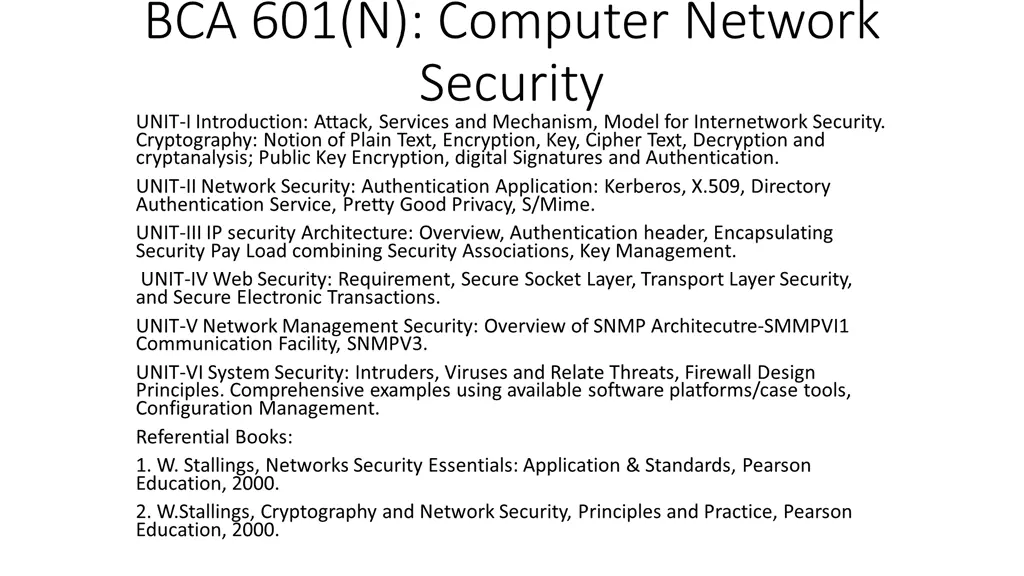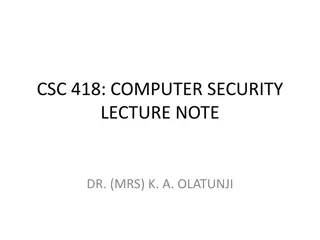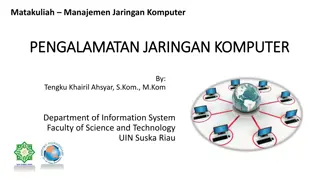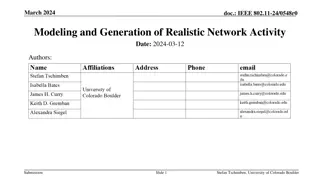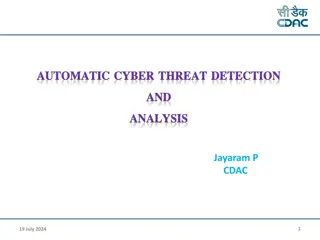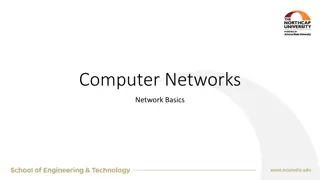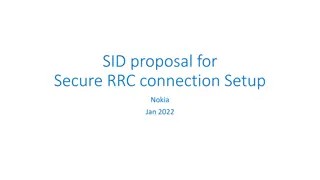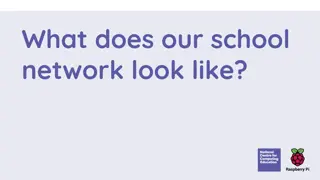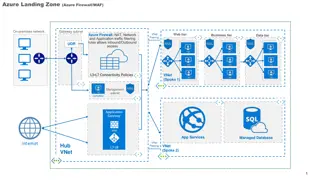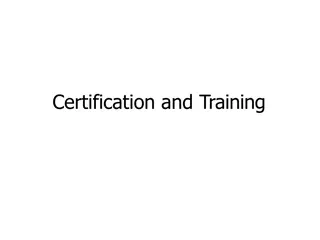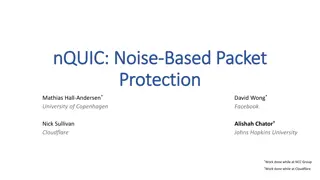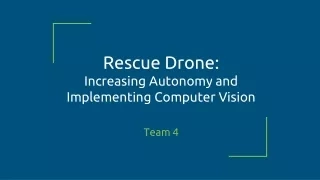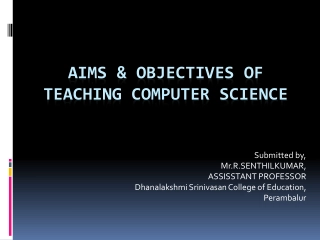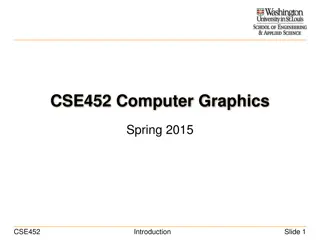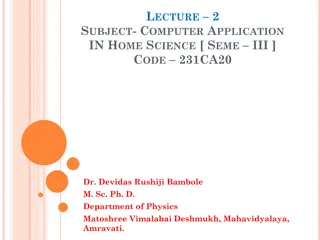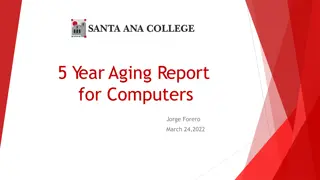BCA 601(N): Computer Network Security
Explore various aspects of computer network security including cryptography, IP security, web security, and system security. Learn about authentication, encryption, key management, and network management security. Real-world examples and best practices covered.
Download Presentation

Please find below an Image/Link to download the presentation.
The content on the website is provided AS IS for your information and personal use only. It may not be sold, licensed, or shared on other websites without obtaining consent from the author. Download presentation by click this link. If you encounter any issues during the download, it is possible that the publisher has removed the file from their server.
E N D
Presentation Transcript
BCA 601(N): Computer Network Security UNIT-I Introduction: Attack, Services and Mechanism, Model for Internetwork Security. Cryptography: Notion of Plain Text, Encryption, Key, Cipher Text, Decryption and cryptanalysis; Public Key Encryption, digital Signatures and Authentication. UNIT-II Network Security: Authentication Application: Kerberos, X.509, Directory Authentication Service, Pretty Good Privacy, S/Mime. UNIT-III IP security Architecture: Overview, Authentication header, Encapsulating Security Pay Load combining Security Associations, Key Management. UNIT-IV Web Security: Requirement, Secure Socket Layer, Transport Layer Security, and Secure Electronic Transactions. UNIT-V Network Management Security: Overview of SNMP Architecutre-SMMPVI1 Communication Facility, SNMPV3. UNIT-VI System Security: Intruders, Viruses and Relate Threats, Firewall Design Principles. Comprehensive examples using available software platforms/case tools, Configuration Management. Referential Books: 1. W. Stallings, Networks Security Essentials: Application & Standards, Pearson Education, 2000. 2. W.Stallings, Cryptography and Network Security, Principles and Practice, Pearson Education, 2000.
Introduction: What is the need of this topic In this age of universal electronic connectivity, of viruses and hackers, of electronic eavesdropping and electronic fraud, computer network security matters the most. Two trends have come together to make the topic of this course of vital interest. First, the explosive growth in computer systems and their interconnections via networks has increased the dependence of both organizations and individuals on the information stored and communicated using these systems. This, in turn, has led to a heightened awareness of the need to protect data and resources from disclosure, to guarantee the authenticity of data and messages, and to protect systems from network-based attacks. Second, the disciplines of cryptography and network security have matured, leading to the development of practical, readily available applications to enforce network security.
Examples of security violation The field of network and Internet security consists of measures to deter, prevent,detect, and correct security violations that involve the transmission of information. consider the following examples of security violations: 1. User A transmits a file to user B. The file contains sensitive information (e.g., payroll records) that is to be protected from disclosure. User C, who is not authorized to read the file, is able to monitor the transmission and capture a copy of the file during its transmission. 2. A network manager, D, transmits a message to a computer, E, under its management. The message instructs computer E to update an authorization file to include the identities of a number of new users who are to be given access to that computer. User F intercepts the message, alters its contents to add or delete entries, and then forwards the message to computer E, which accepts the message as coming from manager D and updates its authorization file accordingly. 3. Rather than intercept a message, user F constructs its own message with the desired entries and transmits that message to computer E as if it had come from manager D. Computer E accepts the message as coming from manager D and updates its authorization file accordingly.
COMPUTER SECURITY CONCEPTS COMPUTER SECURITY CONCEPTS COMPUTER SECURITY The protection afforded to an automated information system in order to attain the applicable objectives of preserving the integrity, availability, and confidentiality of information system resources (includes hardware, software, firmware, information/data, and telecommunications). This definition introduces three key objectives that are at the heart of computer security: Confidentiality: This term covers two related concepts: Data confidentiality: Assures that private or confidential information is not made available or disclosed to unauthorized individuals. Privacy: Assures that individuals control or influence what information related to them may be collected and stored and by whom and to whom that information may be disclosed. Integrity: This term covers two related concepts: Data integrity: Assures that information and programs are changed only in a specified and authorized manner. System integrity: Assures that a system performs its intended function in an unimpaired manner, free from deliberate or inadvertent unauthorized manipulation of the system. Availability: Assures that systems work promptly and service is not denied to authorized users.
characterization of these three objectives in terms of requirements and the characterization of these three objectives in terms of requirements and the definition of a loss of security in each category: definition of a loss of security in each category: Confidentiality: Preserving authorized restrictions on information access and disclosure, including means for protecting personal privacy and proprietary information. A loss of confidentiality is the unauthorized disclosure of information. Integrity: Guarding against improper information modification or destruction, including ensuring information nonrepudiation(Provides protection against denial by one of the entities involved in a communication of having participated in all or part of the communication.) and authenticity(The assurance that the communicating entity is the one that it claims to be.). A loss of integrity is the unauthorized modification or destruction of information. Availability: Ensuring timely and reliable access to and use of information. A loss of availability is the disruption of access to or use of information or an information system.
additional concepts are needed to present a additional concepts are needed to present a complete complete picture SECURITY OBJECTIVES picture SECURITY OBJECTIVES Authenticity: The property of being genuine and being able to be verified and trusted; confidence in the validity of a transmission, a message, or message originator. This means verifying that users are who they say they are and that each input arriving at the system came from a trusted source.. Accountability: The security goal that generates the requirement for actions of an entity to be traced uniquely to that entity. This supports nonrepudiation, deterrence, fault isolation, intrusion detection and prevention, and after-action recovery and legal action. Because truly secure systems are not yet an achievable goal, we must be able to trace a security breach to a responsible party. Systems must keep records of their activities to permit later forensic analysis to trace security breaches or to aid in transaction disputes.
Security attacks: Passive attacks :. A passive attack attempts to learn or make use of information from the system but does not affect system resources. Active attacks An active attack attempts to alter system resources or affect their operation.
Passive Attacks Passive Attacks Passive attacks are in the nature of eavesdropping on, or monitoring of, transmissions. The goal of the opponent is to obtain information that is being transmitted. Two types of passive attacks are the release of message contents and traffic analysis. The release of message contents is easily understood (Figure) A telephone conversation, an electronic mail message, and a transferred file may contain sensitive or confidential information. We would like to prevent an opponent from learning the contents of these transmissions.
A second type of passive attack, traffic analysis . Suppose that we had a way of masking the contents of messages or other information traffic so that opponents, even if they captured the message, could not extract the information from the message. The common technique for masking contents is encryption. If we had encryption protection in place, an opponent might still be able to observe the pattern of these messages. The opponent could determine the location and identity of communicating hosts and could observe the frequency and length of messages being exchanged. This information might be useful in guessing the nature of the communication that was taking place.
Consequence of passive attack Passive attacks are very difficult to detect, because they do not involve any alteration of the data. Typically, the message traffic is sent and received in an apparently normal fashion, and neither the sender nor receiver is aware that a third party has read the messages or observed the traffic pattern. However, it is feasible to prevent the success of these attacks, usually by means of encryption. Thus, the emphasis in dealing with passive attacks is on prevention rather than detection.
ACTIVE ATTACK Active attacks involve some modification of the data stream or the creation of a false stream and can be subdivided into four categories: masquerade, replay, modification of messages, and denial of service. A masquerade takes place when one entity pretends to be a different entity (Figure a). A masquerade attack usually includes one of the other forms of active attack. For example, authentication sequences can be captured and replayed after a valid authentication sequence has taken place, thus enabling an authorized entity with few privileges to obtain extra privileges by impersonating an entity that has those privileges. Replay involves the passive capture of a data unit and its subsequent retransmission to produce an unauthorized effect (Figure b). Modification of messages simply means that some portion of a legitimate message is altered, or that messages are delayed or reordered, to produce an unauthorized effect (Figure c). For example, a message meaning Allow John Smith to read confidential file accounts is modified to mean Allow Fred Brown to read confidential file accounts. The denial of service prevents or inhibits the normal use or management of communications facilities (Figure d). This attack may have a specific target; for example, an entity may suppress all messages directed to a particular destination (e.g., the security audit service).Another form of service denial is the disruption of an entire network, either by disabling the network or by overloading it with messages so as to degrade performance.
Consequence of Active attack Active attacks present the opposite characteristics of passive attacks. Whereas passive attacks are difficult to detect, measures are available to prevent their success. On the other hand, it is quite difficult to prevent active attacks absolutely because of the wide variety of potential physical, software, and network vulnerabilities. Instead, the goal is to detect active attacks and to recover from any disruption or delays caused by them.
SECURITY SERVICES SECURITY SERVICES It is defined as a processing or communication service that is provided by a system to give a specific kind of protection to system resources; security services implement security policies and are implemented by security mechanisms
SECURITY MECHANISMS SECURITY MECHANISMS
A (general)model for Network Security A model for much of what we will be discussing is captured, in very general terms, in the Figure A message is to be transferred from one party to another across some sort of Internet service. The two parties, who are the principals in this transaction, must cooperate for the exchange to take place. A logical information channel is established by defining a route through the Internet from source to destination and by the cooperative use of communication protocols (e.g., TCP/IP) by the two principals. Security aspects come into play when it is necessary or desirable to protect the information transmission from an opponent who may present a threat to confidentiality, authenticity, and so on. All the techniques for providing security have two components:
*A security-related transformation on the information to be sent. Examples include the encryption of the message, which scrambles the message so that it is unreadable by the opponent, and the addition of a code based on the contents of the message, which can be used to verify the identity of the sender. * Some secret information shared by the two principals and, it is hoped, unknown to the opponent. An example is an encryption key used in conjunction with the transformation to scramble the message before transmission and unscramble it on reception. A trusted third party may be needed to achieve secure transmission. For example, a third party may be responsible for distributing the secret information to the two principals while keeping it from any opponent. Or a third party may be needed to arbitrate disputes between the two principals concerning the authenticity of a message transmission
A (general)model for Network A (general)model for Network Security: contd.. Security: contd.. This general model shows that there are four basic tasks in designing a particular security service: 1. Design an algorithm for performing the security-related transformation. The algorithm should be such that an opponent cannot defeat its purpose. 2. Generate the secret information to be used with the algorithm. 3. Develop methods for the distribution and sharing of the secret information. 4. Specify a protocol to be used by the two principals that makes use of the security algorithm and the secret information to achieve a particular security service.
Network Access Security Model Network Access Security Model A different model for some specific situation will be illustrated here. This reflects a concern for protecting an information system from unwanted access. This is caused by the existence of hackers, who attempt to penetrate systems that can be accessed over a network. The hacker can be someone who, with no malign intent, simply gets satisfaction from breaking and entering a computer system. The intruder can be a disgruntled employee who wishes to do damage or a criminal who seeks to exploit computer assets for financial gain (e.g., obtaining credit card numbers or perform illegal money transfer)
Network Access Security Model Network Access Security Model Another type of unwanted access is the placement in a computer system of logic that exploits vulnerabilities in the system and that can affect application programs as well as utility programs, such as editors and compilers. Programs can present two kinds of threats: Information access threats: Intercept or modify data on behalf of users who should not have access to that data. Service threats: Exploit service flaws in computers to inhibit use by legitimate users. Viruses and worms are two examples of software attacks. Such attacks can be introduced into a system by means of a disk that contains the unwanted logic concealed in otherwise useful software. They can also be inserted into a system across a network; this latter mechanism is of more concern in network security.
Model contd. . Network Access Security Network Access Security Model contd The security mechanisms needed to cope with unwanted access fall into two broad categories ( Figure). The first category might be termed a gatekeeper function. It includes password- based login procedures that are designed to deny access to all but authorized users and screening logic that is designed to detect and reject worms, viruses, and other similar attacks. Once either an unwanted user or unwanted software gains access, the second line of defense consists of a variety of internal controls that monitor activity and analyze stored information in an attempt to detect the presence of unwanted intruders
